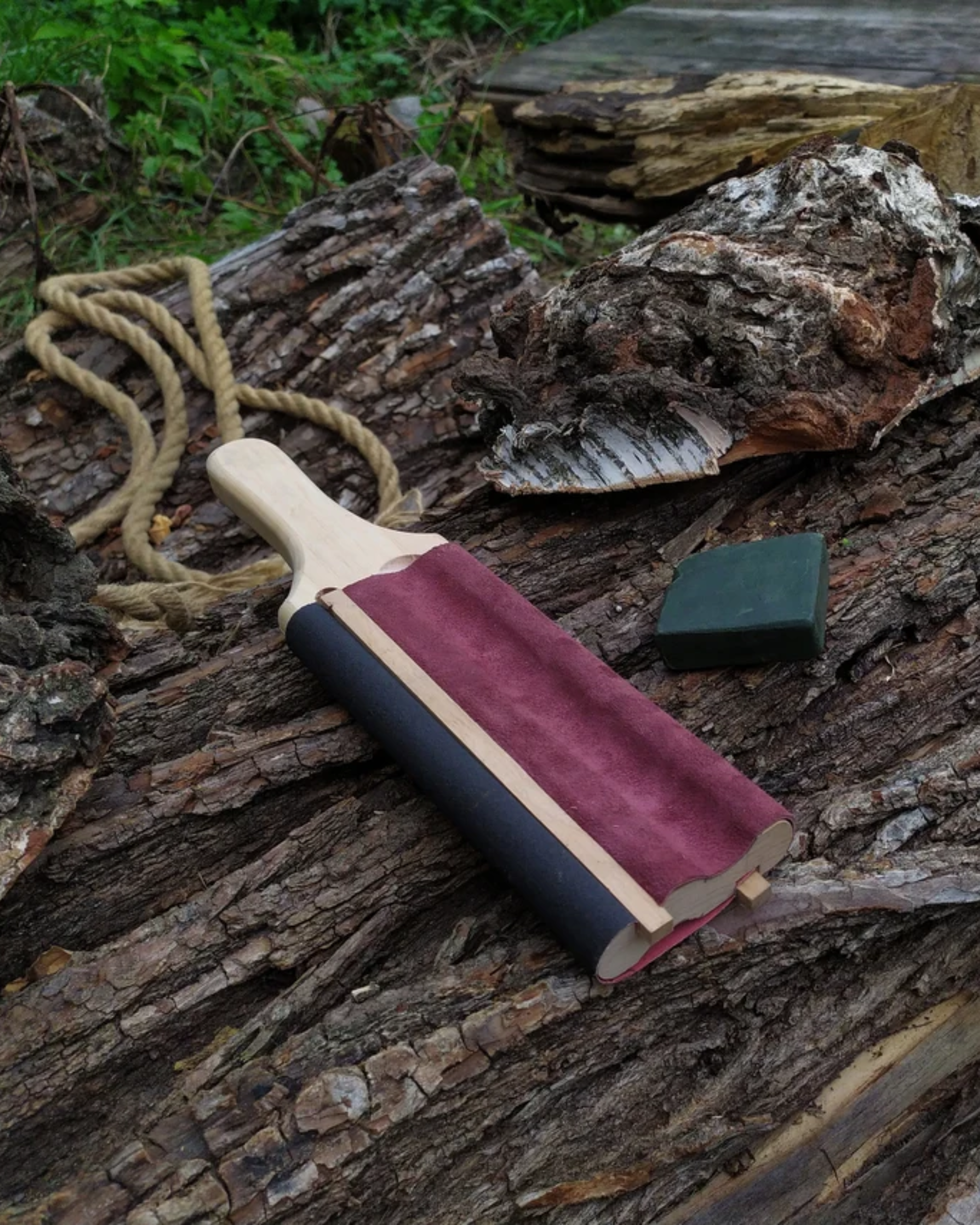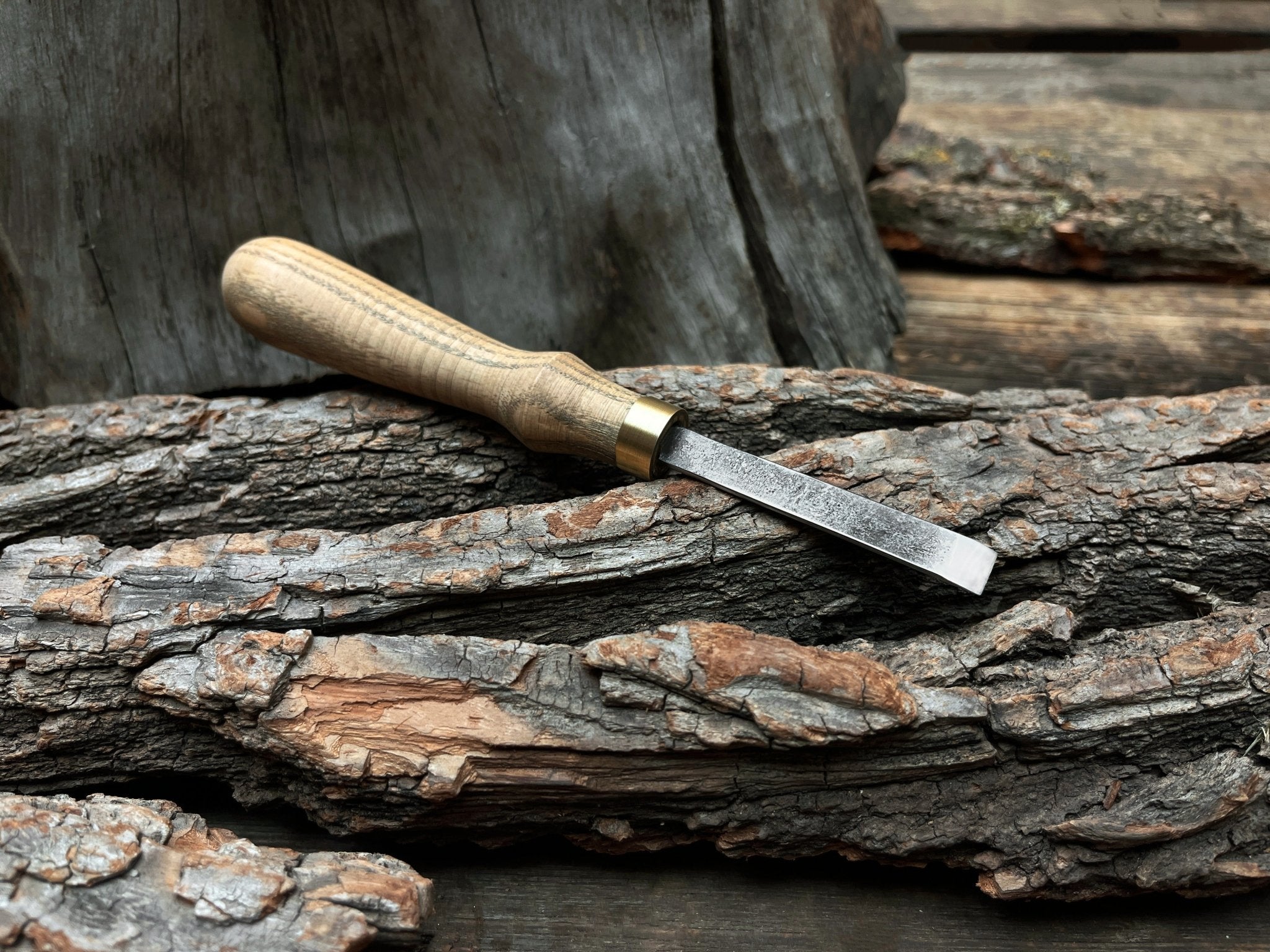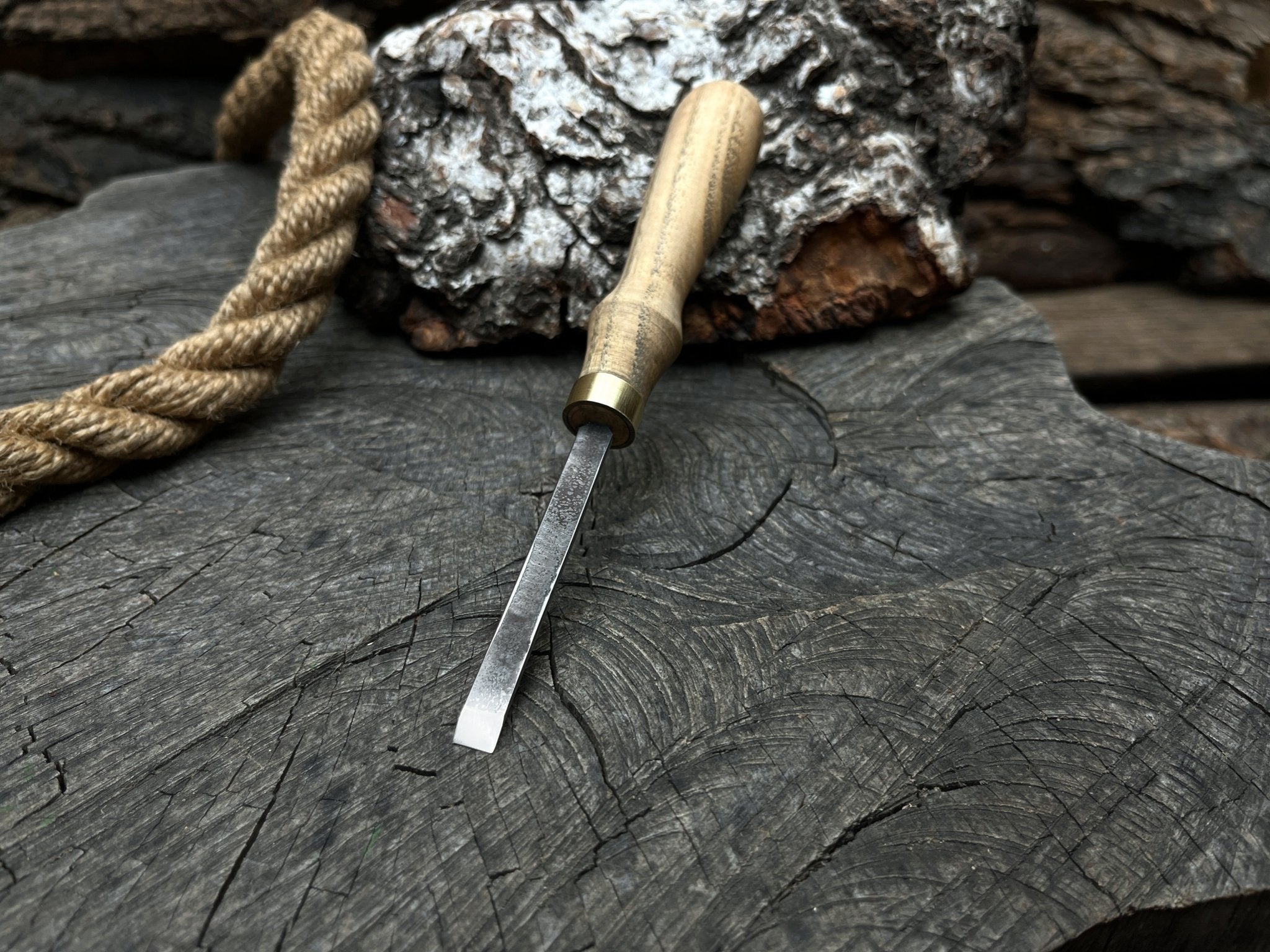Hand-Forged Wood Carving Chisel, 10 - 50 mm (0.39 - 1.97 inches)
Hand-Forged Wood Carving Chisel, 10 - 50 mm (0.39 - 1.97 inches)
Hand-Forged Wood Carving Chisel, 10 - 50 mm (0.39 - 1.97 inches)

Overview of Chisels
Similar to a carving knife, a chisels tool is a tool with a long history. Made from flint, chisels were used centuries ago for stone carving and woodworking. Today, carving chisels haven’t changed in purpose; craftsmen still use them to shape and carve wood, stone, and metal.
These carving tools consist of handles and long, sharp blades with one beveled cutting edge. They can be driven into material with a mallet or hammer for more controlled actions. Based on the material a chisel is intended for, three main categories of tools are distinguished:
- Woodworking chisels are meant to shape and carve wood. Some of the wood carving chisels that belong to this group include:
- Bench chisels, used for general-purpose cutting, paring, and shaping wood.
- Paring chisels, suited for precise shaving thanks to their long and thin blades.
- Skew chisels, which feature skewed blades suitable for making angled cuts.
- Mortise chisels, designed to make mortises with a thick blade.
- Metalworking chisels are made from hardened steel to handle heavy-duty tasks like cutting metal. This group includes:
- Cold chisels, which often have flat blades made from hardened steel to work with cold metal.
- Cape chisels, designed to create flat grooves for keyways or slots with their wedge-shaped heads. The cutting edge narrows into a flat edge for more precise cutting.
- Diamond point chisels, which are used for detailing metal surfaces. They cut V grooves, make sharp corners, and help clean out tight areas.
- Stoneworking chisels are created to carve stone and concrete, typically used in masonry to shape stone materials.
- Point chisels feature pointed tips to break masonry materials.
- Flat chisels feature straight and flat beveled edges with cylindrical handles; the overall shape resembles a narrow wedge. These chisels are used for fine details on sculptures and carvings, rough shaping of stones, bricks, and concrete, as well as for smoothing out surfaces by removing tool marks.
Key Features to Look for in a Chisel
It’s a rule of thumb to always match a chisels tool to the task and material you are going to work with, e.g., hardwoods may require larger carving chisels to tackle heavy-duty tasks.
We recommend starting with a basic set of carving tools that are multipurpose. You may want to pick out a starter tool set consisting of bench, mortise, and paring chisels, all of which can be used for a variety of tasks and serve you well while you hone your metalworking or carving skills.
Blade material:
For hand chisels, blade material is fundamental, as sharpness and durability largely depend on it. High-carbon steel is best known for its ability to hold sharp edges and being easy to sharpen, and is commonly used in woodworking. Tool steel, containing chromium, vanadium, and molybdenum, is suited for both woodworking and metalworking.
Blade width:
- Narrow blades: Available in sizes of ¼-⅛ inches, these can help you carve fine details, cut narrow mortises, and work in tight areas.
- Medium blades: Widths range between ⅜-¾ inches, used for general woodworking, larger mortise and tenon joints. These are a good choice for rough and fine work.
- Wide blades: Blade widths vary from 1 to 2 inches. They are ideal for removing large amounts of material, flattening surfaces, and smoothening the bottoms of joints. They offer efficient material removal and control in larger projects.
Blade length:
- Short blades: These blades range from 2 to 4 inches in lenght. These chiseling tools provide more control when working in tight areas, they can also be used for heavy chopping.
- Medium blades: 4-6 inch chisels are suitable for general joinery, paring, creating bevels along the edges of a material, chopping, trimming excess wood, and smoothing surfaces.
- Long blades: 6-inch and longer blades can be used for deep cuts, such as cleaning out deep grooves, leveling surfaces, controlled paring strokes to remove thin layers of wood, flattening larger panels, and creating long bevels.
Handle design and comfort:
Modern chiseling tools use various materials for handles, including wood, plastic, metal, and rubber:
- Wood: Quality wood for chisel handles, especially for woodcarving chisels, often includes hardwoods like beech and ash. Ash and beech handles are durable and provide a comfortable grip and feel. They can withstand repeated strokes with a hammer or mallet and absorb shock evenly. However, ash and hickory, being denser woods, outperform beech, meaning they are less prone to cracks due to continuous heavy use of carpentry chisels. Cons include regular maintenance to prevent splitting over time. The handle itself can be customized; for example, a shorter handle, like in a butt socket chisel, allows detailed work with precision and maneuverability.
- Plastic: Low-maintenance and durable handles, resistant to moisture, though they may not provide the level of grip that a craftsman needs during extended carving sessions. Plastic does not absorb impact as well as wood, which can lead to faster wear and potential damage when struck with a hammer.
- Metal: Perfect for heavy use and extremely durable, but metal handles may be heavier and less comfortable to hold. Metal handles often transmit increased vibration and can be more costly compared to plastic and wood handles.
- Rubber: These handles usually provide a comfort feel, but may wear out faster than wood and plastic. Rubber handles can degrade when exposed to certain oils and chemicals.
Other characteristics that efficient woodworking chisels should have include:
- Sharpness: Carpentry chisels with better edge retention require blade sharpening less often. Maintaining a sharpened edge is crucial, as it guarantees clean, precise cutting motions. Ease of sharpening is another important consideration for woodcarving chisels.
- Steel hardness: Harder steels resist wear better but may be more prone to chipping, while softer steels may deform over time but are easier to sharpen.
- Tang vs. socket construction of hand chisels: Wood chisels featuring tang construction (a thin extension that fits into the handle) may be less expensive and lighter but are more prone to wear. Socket wood carving chisels are preferred for their long-term use, as this type of construction allows for easier handle replacement.
- Handling different types of wood: Wood chisels should be able to handle both soft and hardwoods without chipping or dulling too quickly. Using one type of wood would simplify things, but if you are looking for general-purpose woodcarving chisels, this is something to take into account.
How to Properly Use a Chisel
Techniques for Precise Cuts
Each material demands a different level of force and type of chisel, whether it’s a curved chisel used for scooping out wood, a rounded chisel that creates smooth transitions in wood carvings, or a cold chisel removing large sections of metal.
The key differences in techniques across materials:
- Woodworking: These techniques are primarily used to make controlled and precise cuts, either by hand or with light mallet strikes. Paring, slicing and chopping are among the most common techniques used with woodworking chisels. To shave off the wood, hold the chisel at a low angle and apply gentle pressure to guide the tool while supporting the blade with a thumb or fingers. If large chunks of wood need to be removed, place chisels for woodworking vertically into the wood and strike the handle with a mallet.
- Concrete work: Concrete work involves forceful movements applied to break or remove material. Common techniques include scoring, chipping, and breaking. Scoring involves making shallow lines in concrete to control breakage. In breaking, flat chisels are used for general purposes, and pointed chisels for more precise breaks with a hammer, which is similar to chipping.
- Metal working: Chisels are used to make grooves, cut and shape softer metals like aluminum, copper, and brass with a hammer. In cold chiseling, chisels are placed at the desired angle and struck sharply to cut away excess material. To cut or shape metals, use a marker to draw a precise line, align the chisel with the marked line, and strike it with a hammer. The peeling technique requires holding the tool at a low angle and scraping across the surface.
Sharpening and Maintaining Your Chisels
Similar to carving knives, woodcarving chisels require regular sharpening and maintenance to ensure safety and clean cutting. Dull tools require more force and increase the risk of accidental slips.
Use a honing stone or an appropriate sharpening system tailored to the specific chisel type you are using. For chisels with curved or rounded edges, use specialized sharpening jigs and stones to preserve their unique shape.
Some craftsmen recommend a simple but efficient method of sharpening. It involves using a coarse, medium, and super fine plate, followed by a piece of plywood with leather for polishing. The process creates a burr and refines the edge through progressively finer plates. For fine woodworking, they use a strop and pull the chisel for about 30 minutes on each side to achieve the desired level of sharpness.
After sharpening, always clean and oil the blade and handle, and store the chisel in a blade guard to protect the edge. It is also recommended to regularly inspect handles for wear, especially in woodworking chisels. Timely replacement of loose and cracked handles will add to your safety.
Safety Tips for Using Chisels
- Storing: Cover the chisel blade with a guard to prevent accidental cuts.
- Protective gear: Equip yourself with safety gloves and glasses to shield against debris.
- Hand positioning: Keep your hands behind the chisel blade to avoid injuries if the tool slips.
- Secure the workpiece: Use clamps to firmly hold your workpiece, preventing unexpected movements.
- Controlled striking: Maintain the correct angle and apply controlled, light strikes using a mallet to prevent woodworking chisels from bouncing or slipping.
Why Buy Chisels from Us?
If your main area of interest is woodcrafting, browse a collection of woodworking chisels by Sharky Forged Steel Tools™. With years of experience in crafting chisels, Sharky Forged Steel Tools™ offers chisels sets consisting of 3 to 7 hand-forged tools sets.
You can also choose to invest in individual chisels of your choice: straight, rounded, and timber framing chisels, available in different shapes and sizes. Handles and blades come in various dimensions, allowing you to select the ones that best suit your style of work.
The materials used in these chisels include 52100 carbon steel blades (ASTM A295 standard), with a 59/62 HRC hardness, providing long-lasting edge retention and wear resistance. Handles are made from ash, chosen for its dense structure, lightweight feel, shock absorption, and comfort in the hand. All tools are delivered pre-sharpened and ready for use.
Some chisels sets come with leather chisel rolls as a bonus with your order. There are also several active special offers available, so take this opportunity to grab a set of the best woodworking chisels that will serve you for years to come.











